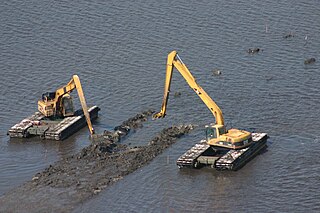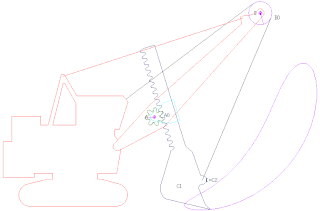 W
WExcavators are heavy construction equipment consisting of a boom, dipper, bucket and cab on a rotating platform known as the "house". The house sits atop an undercarriage with tracks or wheels. They are a natural progression from the steam shovels and often mistakenly called power shovels. All movement and functions of a hydraulic excavator are accomplished through the use of hydraulic fluid, with hydraulic cylinders and hydraulic motors. Due to the linear actuation of hydraulic cylinders, their mode of operation is fundamentally different from cable-operated excavators which use winches and steel ropes to accomplish the movements.
 W
WA compact or mini excavator is a tracked or wheeled vehicle with an approximate operating weight from 0.7 to 8.5 tonnes. It generally includes a standard backfill blade and features independent boom swing.
 W
WThe Caterpillar 345C L is a large hydraulic excavator manufactured by Caterpillar Inc. The 345C L, with 345 hp (257 kW) of net flywheel power, is classified as a large excavator by Caterpillar. In Caterpillar's naming conventions, the last two digits indicate the excavator's weight in metric tonnes. The 345C L is not named after its horsepower. Rather, it is a coincidence that both use the number 345. Caterpillar currently produces the 300 series, including the 345C L.
 W
WAn amphibious excavator is a type of excavator that can perform dredging while afloat on soft terrain such as swamp, wet land, and shallow water. An amphibious excavator is better adapted for removing silty clay, clearing silted trenches, swampland operation, and shallow water operation than traditional barge-mounted dredgers.
 W
WBagger 288, built by the German company Krupp for the energy and mining firm Rheinbraun, is a bucket-wheel excavator or mobile strip mining machine.
 W
WBagger 293, previously known as the MAN TAKRAF RB293, is a giant bucket-wheel excavator made by the German industrial company TAKRAF, formerly an East German Kombinat.
 W
WBagger 1473 is a bucket-wheel excavator left abandoned in a field in the municipality of Schipkau in Germany.
 W
WA bucket chain excavator (BCE) is a piece of heavy equipment used in surface mining and dredging. BCEs use buckets on a revolving chain to remove large quantities of material. They are similar to bucket-wheel excavators and trenchers. Bucket chain excavators remove material from below their plane of movement, which is useful if the pit floor is unstable or underwater.
 W
WA bucket-wheel excavator (BWE) is a large heavy equipment machine used in surface mining.
 W
WDigga is an Australian brand of Machinery Attachments to suit heavy equipment (construction), including excavators, skid steer loaders, telehandlers, truck cranes as well as tractors and mini machines. The company is based in Yatala, Queensland with 5 branches in Australia.
 W
WA dragline excavator is a piece of heavy equipment used in civil engineering and surface mining.
 W
WA gold dredge is a placer mining machine that extracts gold from sand, gravel, and dirt using water and mechanical methods.
 W
WA power shovel is a bucket-equipped machine, usually electrically powered, used for digging and loading earth or fragmented rock and for mineral extraction. Power shovels are a type of rope/cable excavator, where the digging arm is controlled and powered by winches and steel ropes, rather than hydraulics like in the more common hydraulic excavators. Basics parts of a power shovel include the track system, cabin, cables, rack, stick, boom foot-pin, saddle block, boom, boom point sheaves and bucket. The size of bucket varies from 0.375 to 5 cubic metres.
 W
WTwinkle Toes is the largest excavator in the Southern Hemisphere. It was used in Christchurch to demolish tall buildings following the 2010 and 2011 earthquakes before moving to Wellington following the 2016 Kaikoura earthquake.
 W
WThe Ursa Major at Black Thunder Coal Mine, Wyoming, is the largest dragline excavator currently in use in North America and the third largest ever built. It is a Bucyrus-Erie 2570WS model and cost US$50 million. The Ursa Major was one of five large walking draglines operated at Black Thunder, with the next two largest in the dragline fleet being Thor, a B-E 1570W - which has a 97.5m boom and a 69m³ bucket - and Walking Stick, a B-E 1300W with a 92m boom and a 34m³ bucket.
 W
WA walking excavator or popularly spider excavator is a special type of all-terrain excavator. Like the regular excavator it consists of a boom, stick, bucket and cab on a rotating platform known as the "house". However, its house sits atop an undercarriage consisting of leg or arm-like extensions with or without wheels. All extensions can move in increments, hence the name walking excavator. This is different from an early 20th century dragline excavator where a set of feet plate are alternately lifted and lowered.